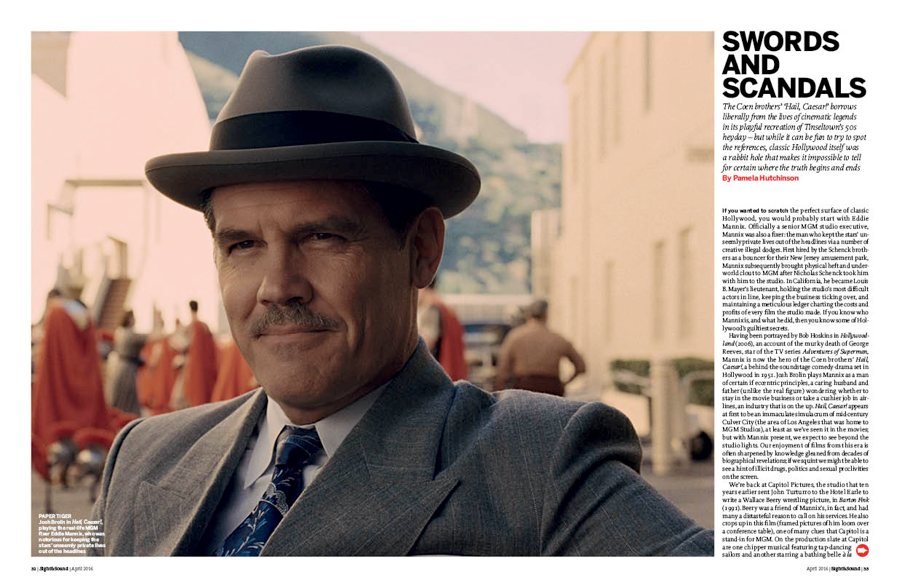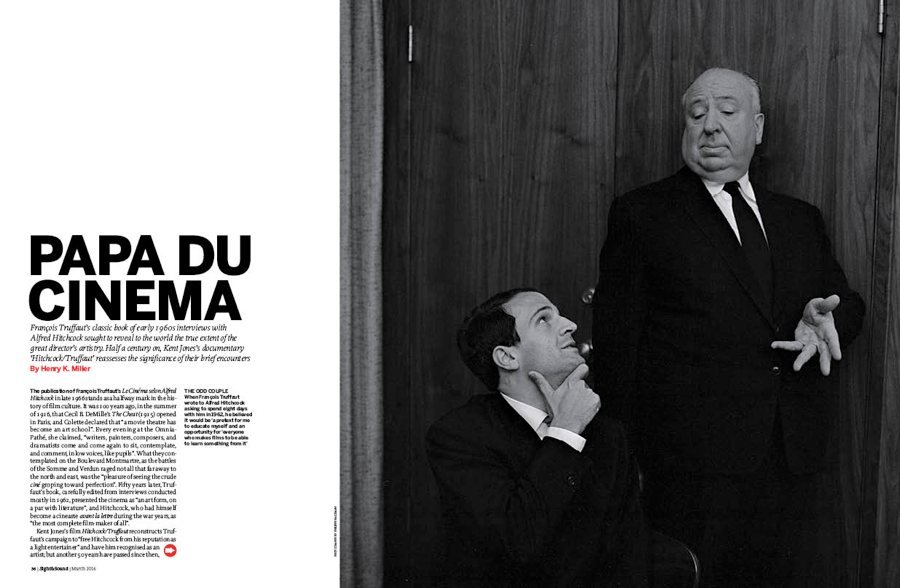Early in Hail, Caesar!, Eddie Mannix (Josh Brolin), a production executive for Capitol Pictures, rescues a budding starlet from a photographer who has her posing for ‘French postcard’ pictures in a bungalow-cum-porn-set reminiscent of the one in The Big Sleep (1946). Waiting in his car in the rain, Mannix looks like a Bogart-type hero; in fact, he’s less concerned about the dame in distress than about damage control for Capitol.
USA/United Kingdom/Japan 2016
Certificate 12A 105m 56s
Directors Joel Coen, Ethan Coen
Cast
Eddie Mannix Josh Brolin
Baird Whitlock George Clooney
Hobie Doyle Alden Ehrenreich
Laurence Laurentz Ralph Fiennes
Joseph Silverman, ‘Joe’ Jonah Hill
DeeAnna Moran Scarlett Johansson
C.C. Calhoun Frances McDormand
Thora Thacker/Thessaly Thacker Tilda Swinton
Burt Gurney Channing Tatum
narrated by Michael Gambon
Dolby Digital
In Colour
[1.85:1]
UK release date 4 March 2016
Distributor Universal Pictures International UK & Eire
hailcaesarmovie.co.uk
► Trailer
The replacement of the upright detective with an industry fixer is emblematic not only of the studios’ real-life obsession with controlling their employees’ private lives but also of what Joel and Ethan Coen are up to in Hail, Caesar! The film’s mission might be to save the movies from themselves – to celebrate the classical system’s capacity to generate delight without overlooking the ugliness and absurdity involved in the process.
Mannix takes his name from a real MGM fixer now associated with as many horrors as favours. The Coens’ Mannix, however, is a fundamentally decent if righteously slap-happy guy, and the story’s straight man. Over 27 fraught hours, he wrangles an aw-shucks cowboy star (Alden Ehrenreich) and the prissy director of drawing-room dramas (Ralph Fiennes) on whom he’s been foisted; deals with the pregnancy of a sass-talking bathing beauty (Scarlett Johansson); negotiates with duelling gossip columnists Thora and Thessaly Thacker (Tilda Swinton, twice); and grapples with a bizarre communist plot to kidnap and indoctrinate a dopey matinee idol (George Clooney), currently playing a centurion at the time of Christ. A gaggle of subversive screenwriters and a tap-dancing ace (Channing Tatum) are also involved. Meanwhile Mannix is being headhunted by Lockheed, the defence giant.
All this takes place against an exquisitely manic backdrop of detailed pastiche. The Coens’ love of classical Hollywood has always been clear in their genre-hopping career path but here they run the gamut within a single movie, taking in Technicolor epic, aquatic spectacular, knockabout western, shore-leave musical and more, all with jauntily askew titles such as Lazy Ol’ Moon, Merrily We Dance and indeed Hail, Caesar! But one needn’t know Hollywood lore inside out to enjoy the gags or the bravura set pieces, which range from theological and dialectical roundtables to high-diving and spaghetti lassos. Unlike the Coens’ last picture, Inside Llewyn Davis (2013), or their previous pass at the classical studio system, Barton Fink (1991), the tone here is predominantly warm-hearted, offering perhaps their most gentle ribbings since Raising Arizona (1987).
Preston Sturges’s teasing Tinseltown meditation Sullivan’s Travels (1941) looms large – as it did in the Coens’ O Brother, Where Art Thou? (2000), which aped Sullivan’s Depression-era setting and embraced the lesson, learnt by its film-director hero, that laughter is “all some people have”. Like Sullivan’s Travels and O Brother, Hail, Caesar! uses a scene of an audience in stitches to illustrate the capacity of moviegoing to generate respite and fellow feeling. In this case, however, the audience is made up not of prison inmates or a church congregation but the tuxedo-clad “swells of dreamland”. Ever sceptical, the Coens disavow any clear-cut rapprochement between artists and ‘the common man’ (Barton Fink’s target audience), even as their affection for the form is writ large.
Where Barton Fink – set at the same fictional studio a decade earlier – was populated almost exclusively by shysters and maniacs, Hail, Caesar! is short on outright charlatans. Although there’s plenty of narrative skulduggery, characters tend to act in the service of conscientiously held belief systems, from communism to Catholicism to the good of the studio. In the battle between Capitol Pictures and Das Kapital, the Coens make both sides look ridiculous but mostly harmless, as Billy Wilder did in his Cold War Coca-Cola send-up One, Two, Three (1961). In a sense, Hail, Caesar! is a film about belief: gotta serve somebody, as its title implies, and we meet many servants of many masters.
As for the Coens themselves, eccentric and critical Hollywood tomb raiders they might be but, like Sturges, they believe sincerely in the value of delight for its own sake. Unlike True Grit (2010) or Inside Llewyn Davis, this picture isn’t dramatically driven; it attends to plot and character but it really revels in the pleasures of technical virtuosity. The riding, dancing, acting, design, choreography and editing skills put to the service of Capitol Pictures are breathtaking. Hail, Caesar! itself, meanwhile, confirms the range of the Coens and their stock company, including costumier Mary Zophres, production designer Jess Gonchor, cinematographer Roger Deakins and musician Carter Burwell.
The man from Lockheed brags about nuking Bikini Atoll, disdains Hollywood as a “circus” and derides Mannix’s job of “babysitting kooks”. But the Coens are all for the circus and the kooks. Like Mannix, they recognise the ‘genius of the system’, that inexplicable mixture of art and commerce that makes for movie magic. In Hail, Caesar!, they express this ethos through a kind of late style that privileges craft and tolerates chaos. Neither high modernist experimental debunkers nor conventional followers of the rules of mass production, the Coens, like the classical directors they have emulated, always remain ‘in but not of’ the confines of Hollywood’s circumscribed dreamland. Here, they serve it like true – if gimlet-eyed – believers.
In the forthcoming April 2016 issue of Sight & Sound

Swords and scandals
The Coen brothers’ Hail, Caesar! borrows liberally from the lives of cinematic legends in its playful recreation of Tinseltown’s 50s heyday – but while it can be fun to try to spot the references, classic Hollywood itself was a rabbit hole that makes it impossible to tell for certain where the truth begins and ends. By Pamela Hutchinson.
→
Also recommended this week

Hitchcock/Truffaut
Director Kent Jones | France/USA 2015 | On limited release
hitchcocktruffaut.co.uk | ► Trailer
A documentary by critic and filmmaker Kent Jones about the eight days of interview critic-turned-filmmaker François Truffaut conducted with Alfred Hitchcock in 1962, which resulted in Truffaut’s famous critical book on Hitchcock. The film also features interview with ten contemporary filmmakers, including David Fincher, Wes Anderson, Olivier Assayas, Richard Linklater and Martin Scorsese. Featured in-depth in Henry K. Miller’s article Papa du Cinema in our March 2016 issue, and reviewed by Richard Combs in the same issue:
“Jones has laid out the stall for his own analytical approach to Hitchcock: “I didn’t want experts, historians or critics… What I wanted was to continue the dialogue between the two filmmakers by bringing in ten more filmmakers – people who were into sharing their craft.”
and
Time Out of Mind
Director Oren Moverman | USA 2014 | On limited release
► Trailer
A lyrical, dramatic two-hander between Richard Gere’s long-term homeless drunk and Ben Vereen’s battered ex-musician. Reviewed by Lisa Mullen in our March 2016 issue:
“By constantly sabotaging our expectation of a clear view, Moverman comes close to alienating and exasperating the audience, but the film is finally persuasive in its attempt to make us share the helpless passivity that George succumbs to, and the frustration of the well-meaning people who don’t just walk by but try to come to his aid.”
-
The Digital Edition and Archive quick link
Log in here to your digital edition and archive subscription, take a look at the packages on offer and buy a subscription.










